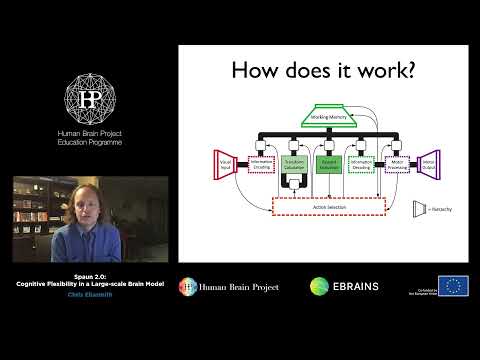I get really sick of hearing about OpenAI and the rest of the LLM crowd making absurd claims about LLMs like ChatGPT being AGI. LLMs are not even close to AGI. If you want to see real research into AGI, watch this video on Chris Eliasmith's Spaun (semantic pointer architecture unified network). It may not look as snazzy and consumer-ready as all these hallucinating LLMs being marketed to us, but this is the real deal: A single system that can do lots of different things the brain does and that LLMs can never do.
https://youtu.be/I5h-xjddzlY?si=a-dS3yUPtioypa7P
#Spaun
#ArtificialGeneralIntelligence #AGI #AI #ML
#SemanticPointerArchitecture #SPA
#Nengo
#Hypervectors
#VectorSymbolicArchitecture #VSA
#HyperdimensionalComputing #HDC
#HolographicReducedRepresentation #HRR
#OpenAI #ChatGPT #LLM #LLMs

Eliasmith Chris - Spaun 2.0: Cognitive Flexibility in a Large-scale Brain Model
@root The closest technologies we have to how the human brain works are not LLMs, but some less well-known ones: reinforcement learning algorithms and hyperdimensional computing. If you want to see what HDC is capable of, check out this video:
https://youtu.be/P_WRCyNQ9KY?si=JgAuOJQmsQ6tVIiO
#HDC #HyperdimensionalComputing
#VSA #VectorSymbolicArchitecture
#HRR #HolographicReducedRepresentation
#SpikingNeuralNetworks
#AGI #ArtificialGeneralIntelligence
#LLM

Spaun brain activity and decoding for sample tasks
VSAONLINE - Spring 2025
CHECK THE UPCOMING EVENTS TOWARDS THE END OF THIS PAGE!
I was looking through the VSAonline website (https://sites.google.com/view/hdvsaonline/home) and saw that by the end of this year there will be 96 recorded webinars plus the recordings from the Midnight Sun 2023 workshop.
So, if you're interested in #VectorSymbolicArchitecture / #HyperdimensionalComputing or just #VSA / #HDC -curious, the VSAonline website is the place to go (or head over to https://www.hd-computing.com/home, where there's a wider range of resources, including publication lists).
#CognitiveScience #CogSci #ComputationalCognitiveScience #CompCogSci #AI #ArtificialIntelligence #ML #MachineLearning #neuromorphic #ComputationalNeuroscience
VSAONLINE
If you want to give a credit to this webinar series use the following entry when citing (BibTeX).
Vector Symbolic Architectures (VSA), which is also known as hyperdimensional computing (HDC) is a subclass of cognitive computing architectures, which is rooted in the observation that key aspects of
Event:
* "Unlocking Tomorrow's Technology: Hyperdimensional Computing and Vector Symbolic Architectures for Automation and Design in Technology and Systems"
* 27 March 2024, Valencia, Spain
* A workshop of the Date24 conference
* https://www.date-conference.com/workshop/w05
Invited speakers:
* Evgeny Osipov
* Abbas Rahimi
* Alpha Renner
* Kenny Schlegel
CFP:
* Poster proposals can be submitted in the form of abstracts
* Deadline 5 February 2024
* https://easychair.org/conferences/?conf=date24w05
#VSA #VectorSymbolicArchitecture #HDC #HyperdimensionalComputing #CogSci #CognitiveScience @cogsci #neuromorphic #AI #ArtificialIntelligence
W05 Unlocking Tomorrow's Technology: Hyperdimensional Computing and Vector Symbolic Architectures for Automation and Design in Technology and Systems | DATE 2024
**Submission deadline extended to 2024-01-29**
Antonello Rosato (Sapienza University of Rome) has organised a half-day workshop on Vector Symbolic Architectures / Hyperdimensional Computing, to be held in Valencia, Spain, on 27 March 2024 as part of the Design, Automation and Test in Europe Conference (DATE24):
https://www.date-conference.com/workshop/w05
#VSA #VectorSymbolicArchitecture #HDC #HyperdimensionalComputing
#CogSci #CognitiveScience #CogRob #CognitiveRobotics #AI #ArtificialIntelligence #neuromorphic
W05 Unlocking Tomorrow's Technology: Hyperdimensional Computing and Vector Symbolic Architectures for Automation and Design in Technology and Systems | DATE 2024
Here's a really interesting (long) paper on what a theory of computing based on arbitrary physical substrates might look like: http://arxiv.org/abs/2307.15408
"Toward a formal theory for computing machines made out of whatever physics offers: extended version"
Herbert Jaeger, Beatriz Noheda, Wilfred G. van der Wiel (2023)
@bnoheda
#NewPaper #TheoreticalComputerScience #neuromorphic #CogSci #CognitiveScience #VSA #VectorSymbolicArchitecture #HDC #HyperdimensionalComputing #AnalogComputing

Toward a formal theory for computing machines made out of whatever physics offers: extended version
Approaching limitations of digital computing technologies have spurred
research in neuromorphic and other unconventional approaches to computing. Here
we argue that if we want to systematically engineer computing systems that are
based on unconventional physical effects, we need guidance from a formal theory
that is different from the symbolic-algorithmic theory of today's computer
science textbooks. We propose a general strategy for developing such a theory,
and within that general view, a specific approach that we call "fluent
computing". In contrast to Turing, who modeled computing processes from a
top-down perspective as symbolic reasoning, we adopt the scientific paradigm of
physics and model physical computing systems bottom-up by formalizing what can
ultimately be measured in any physical substrate. This leads to an
understanding of computing as the structuring of processes, while classical
models of computing systems describe the processing of structures.
@thezerobit for fielded devices I gotta agree. However, for algorithmic explanation of an approach to computing that might *actually* be well suited to memristors (and other proposed noisy hardware technologies) there's a reasonable amount of activity in the Vector Symbolic Architecture / Hyperdimensional Computing space:
https://duckduckgo.com/?t=h_&q=memristor+%22vector+symbolic+architecture%22+&ia=web
https://duckduckgo.com/?t=h_&q=memristor+hyperdimensional+&ia=web
#memristor #neuromorphic #VSA #VectorSymbolicArchitecture #HDC #HyperdimensionalComputing
memristor "vector symbolic architecture" at DuckDuckGo
DuckDuckGo. Privacy, Simplified.
MIDNIGHTVSA - Abstracts
Keynote 1. Ross Gayler. Thinking about Vector Symbolic Architectures.
Abstract: Vector Symbolic Architectures are defined in terms of a very small set of operators acting on a vector space. The task of the VSA researcher is to discover the implications that follow from the definition in terms of
- YouTube
Auf YouTube findest du die angesagtesten Videos und Tracks. Außerdem kannst du eigene Inhalte hochladen und mit Freunden oder gleich der ganzen Welt teilen.

